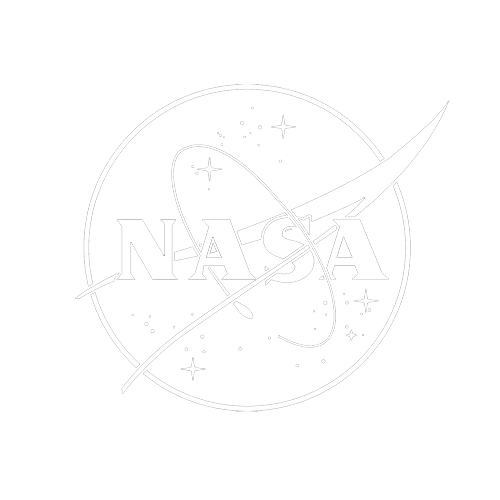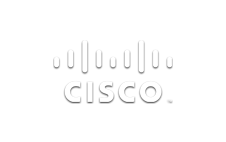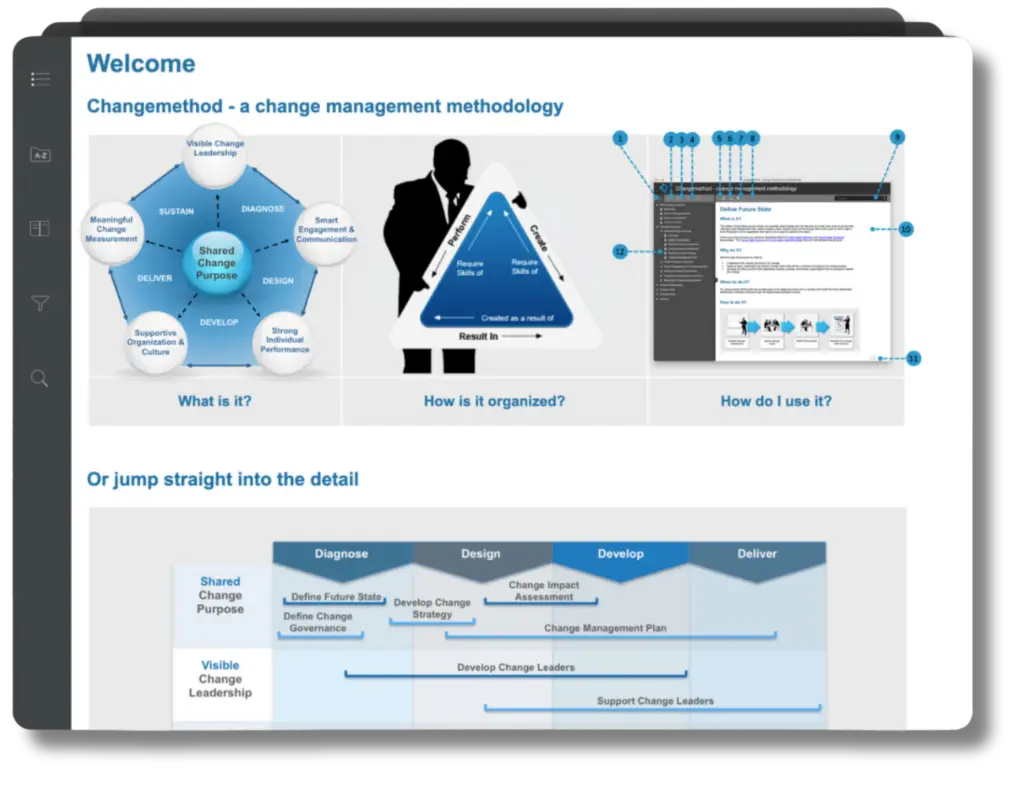Built around 6 essential areas of change management best practice
Shared Change Purpose
A change management strategy should be compelling and consistent with a vision of the future business environment, and the implications for the future state of the organization. The processes here aid clarity of thinking in this respect and define measurable targets for the change project or programme.
It also offers an opportunity to collaborate with employees across the organization so that vision and strategy of the future state of the organization is a collective one. The visioning activity shouldn’t be undervalued as lightweight or unnecessary. At some point in the future, as the change programme progresses and we get into the nitty-gritty, you will be glad to have captured this reference point.
Key Change Question:
What do we think the future business environment will look like and how do we want to be as an organization in advance of reaching it?
Define Future State
Purpose
Benefit if used
Risk if ignored
Tools & Templates
Define clear and compelling picture of future organisation (‘what change looks like’).
Identify capability requirements to drive change.
Absence of shared purpose, no clear target or direction forward.
Evaluate gap between current and future organization; develop high level roadmap for change.
Unite around clear understanding of change drivers and change vision.
People and organizational change lag behind the imperative for change.
Define Change Governance
Purpose
Benefit if used
Risk if ignored
Tools & Templates
Specify decision rights and accountability framework for change program.
Supports decisive change leadership.
Lack of ‘joined-up’ change management strategy and plan.
Align with existing project and organization governance structures.
Enables clear accountability for change program.
Change solution disconnected from wider organization and/or end user needs.
Provides quality assurance and path to escalate issues and risks.
Resistance to change builds, progress towards future state obstructed.
Develop Change Strategy
Purpose
Benefit if used
Risk if ignored
Tools & Templates
Describe reasons for changing, what you want to achieve and how you will get there.
Compile a concrete business case describing both the financial and non-financial benefits of the change effort.
Disconnect between change vision and best path to building new capabilities.
Change Management Strategy underpins plan and all subsequent activity.
Describe the overall approach to managing the impact of change.
No clear alignment of financial and non-financial benefits and risks of change program.
Change Impact Assessment
Purpose
Benefit if used
Risk if ignored
Tools & Templates
Capture people and organizational impacts arising from the change being introduced.
Rank the type and magnitude of change impacts for each stakeholder group.
No clear understanding of people and change impacts, no basis for strategy and plan, significantly higher risk of project failure.
Critical input into change management strategy and plan.
Support change leadership with clear insights into challenges and reduce risk.
Change Management Plan
Purpose
Benefit if used
Risk if ignored
Tools & Templates
Define sequence of tasks, activities, deliverables and resources required to execute change strategy.
Describe in concrete terms how change strategy will be executed.
Lack of alignment between strategy and solution, stakeholders become disengaged, increased costs of higher risk of project failure.
Apply project management discipline through phases, workstreams, decision points and milestones.
Facilitate successful transition of people and organization elements of the program from current to future state.
Visible Change Leadership
Change Leadership is the ability of those who direct, plan, and guide the organisation through changes in order to accomplish its goals. The change leadership process is about developing executives to effectively lead the change at various levels in the organisation. It helps leaders to understand their roles and responsibilities and serve as role models for the desired behaviours in the workforce.
Successful change leaders create a shared vision for change, gain commitment to the change goals and lead their people through transformational change.
Key Change Question:
Who, from amongst or around us, will show the way and what qualities and capabilities will be required of them?
Develop Change Leaders
Purpose
Benefit if used
Risk if ignored
Tools & Templates
Leader capacity to inspire and steer organization through a period of change and achieve strategic objectives.
Change leadership interventions targeted where most needed.
Absence of effective direction, guidance and support for change program.
Identify change leadership requirements, assess existing capability and address gaps through leadership action plans.
Senior leader styles aligned requirements of the change program.
Inability to move beyond status quo.
Evaluate the effectiveness of change leadership interventions.
Change visibly supported by leaders, stakeholder more likely to embrace new ways of working and change program benefits realized.
Undermines leadership authority and future capacity for change.
Support Change Leaders
Purpose
Benefit if used
Risk if ignored
Tools & Templates
Recognizes change leadership is not a one-time event or process: it must be fostered in order to flourish.
Develop individual change leader confidence.
Visible disconnect between change leadership words and actions.
Provide coaching support to unlock individual change leader competencies and behaviors
Increase change leader ability to inspire stakeholder commitment to change.
High level of employee disengagement.
Increased speed of adoption, change program benefits and ROI.
Low levels of adoption and benefit realization, wasted financial investments.
Smart Engagement & Communication
Communication, as a central part of change management, has almost become something of a cliche. Strip it all down to the bones, though, and we see identifying, communicating and ‘managing’ the commitment of key project stakeholders is a critical component to the success of any project.
The processes here aim to ensure the right message is delivered by the right people at the right time and using the most appropriate method. Smart stakeholder engagement and communication makes clear what is happening, what is expected, how to get involved and can removes otherwise many unavoidable obstacles to change.
Key Change Question:
Which individuals or groups have the ability to help or hinder the change programme and what is the best way to identify, track and manage these relationships?
Stakeholder Analysis
Purpose
Benefit if used
Risk if ignored
Tools & Templates
Identify and segment change sponsors, advocates, agents and targets of the change
Identify capability requirements to map varying levels of stakeholder commitment and willingness to change
No basis upon which to develop change strategy
Understand stakeholder wants and needs as well as where they are on the change commitment curve and where they need to be for change to happen
Focus effort and energy on ‘mission critical’ stakeholders
No basis for understanding where and how to target change management interventions
Guide stakeholder groups and individuals towards the desired commitment for change necessary for the success of the program
Resistance to change unchecked, costs increase, change program aborted
Build Change Agent Network
Purpose
Benefit if used
Risk if ignored
Tools & Templates
Establish a network of motivated and competent change sponsors, agents, advocates, targets
Increased stakeholder engagement and communication effectiveness
Loss of key communication and control mechanism
Support, evaluate and fine-tune performance of change network throughout program
Smarter, better and faster implementation through close knitting of senior leadership, change team and impacted stakeholders
Reduces effectiveness of change leadership investment and activity
Provides linkage between change program leadership and impacted stakeholders
Increased risk of project failure
Stakeholder Communication
Purpose
Benefit if used
Risk if ignored
Tools & Templates
Develop and implement a change-specific communication strategy and plan
Fosters understanding, acceptance and ownership of the change within organization
Need for change never fully recognized or embraced
Create engaging communication and dialogue to move stakeholders along the change commitment curve
Increases accuracy of transmitted information, reinforces organization’s vision and positively sustain morale
Little or no behavior change, business readiness activities frustrated, delayed go-live or project shut-down
Enable people to understand what they need to do differently in the new organizational model
Strong Individual Performance
Successful change typically involves changing the way people work, allowing for individual employees to adopt and and own the new process, technology and ways of working required to bring about the organizational change.
Learning & Performance Support ensures that all workforces impacted by the change have the requisite knowledge, skills and abilities required to deliver the change. Significant change may require training to support the behavioural or product elements of the change. In addition, for the programme to deliver upon its objectives, it is essential that a consistent performance management process is in place that provides easily understood standards of performance and behaviour to be achieved by the employees affected by the change.
Key Change Question:
What incentives, skills and processes need to be in place for people to perform appropriately and effectively in the future state organization?
Knowledge and Skill Assessment
Purpose
Benefit if used
Risk if ignored
Tools & Templates
Determine whether employees impacted by the change have requisite knowledge and skill to meet new ways of working
Identify competency strengths that can be exploited to support change
No clear picture of knowledge and skill gap resulting in implementation of ineffective change interventions
Key input into performance management, talent management and training activity
Directs attention and resource to performance management, talent management and training interventions most likely to be effective and deliver change benefits
Effective Performance Management
Purpose
Benefit if used
Risk if ignored
Tools & Templates
Determine how the change program impacts the definition, measurement, motivation, and management of employees’ performance
Clear alignment of employee objectives with strategic direction of change
Commitment to change remains low
Ensure rewards program supports overall strategic objectives
Ensures support provided for people who need to develop knowledge, skill and competency in their new roles
Difficult to achieve behavior change and realize program benefits
Effective Talent Management
Purpose
Benefit if used
Risk if ignored
Tools & Templates
Determine how the change program impacts the definition, measurement, motivation, and management of employees’ performance.
Ensure right resources with right skills assigned to roles critical to drive change.
Change effort unable to move from acceptance and commitment to behavior change.
Ensure rewards program supports overall strategic objectives.
Realize benefits made from human capital investments.
Overall change program success at risk.
Effective Training and Knowledge Management
Purpose
Benefit if used
Risk if ignored
Tools & Templates
Develop training and knowledge management strategies to effectively enable the operational change.
Faster time to competency: employees more quickly able to perform in new jobs, use new systems etc.
Slower speed to competency, higher costs.
Realize benefits made from human capital investments.
Drop in service or productivity for business as usual.
Supportive Organization & Culture
Almost all change initiatives will have some implication for the architecture of an organization, whether limited to reworking role descriptions following a process change or rolling out a new operating model following M&A activity.
The processes contained within this best practice area define the implications of the change programme for the organisation structure, and aligns the organisation to the future business processes. It is used as a framework in which specific roles, jobs and teams will be defined. It serves as a basis to define the transition approach to the new organisation structure. Culture is simply the expression of the values of an organization, ‘the way we do things around here’, and as such can be the great, intangible ‘something’ that tips the balance of project into success or failure.
Key Change Question:
How should we arrange ourselves – our structure, processes and systems – to support the changed way of working? And what are the values, attitudes and behaviors we want to collectively embody?
Business Process Alignment
Purpose
Benefit if used
Risk if ignored
Tools & Templates
Align changed business processes to business roles and – where there is a system element – end users.
Ensure process, people and organization elements of the change are all ‘joined up’.
Organization structure not aligned with future state processes.
Inefficient allocation of work activity.
Prepare Organization Design
Purpose
Benefit if used
Risk if ignored
Tools & Templates
Reconfigure organization structure in order to enable operational change.
Ensure new organization structure supports overall strategic objectives of change program.
Organization structure not aligned with future state processes.
Address formal and informal structures, internal processes and systems, relationships, people and knowledge.
Provide effective framework for roles, jobs and teams to function
Inefficient allocation of work activity.
Implement Organization Design
Purpose
Benefit if used
Risk if ignored
Tools & Templates
Describe activities required to transition from current to future job, team and organization structures.
Facilitate smooth transitions of impacted stakeholders into new roles, jobs, and teams.
Major disruption to business as usual, change program benefits at risk.
Culture Change Analysis
Purpose
Benefit if used
Risk if ignored
Tools & Templates
Define core values, cultural characteristics and individual behaviors required to deliver the change strategy.
Engage employees in determining what the future culture of the organization should look like, increaase buy-in.
Existing cultural norms undermine adoption of change, uphill task to realize business benefits of change program.
Key input into behavior change and change leadership development programs.
Address critical success factor needed to bring change to life and deliver business benefits.
Leaves legacy of ‘change doesn’t work here’, reduces change agility.
Behavior Change Plan
Purpose
Benefit if used
Risk if ignored
Tools & Templates
Define specific behavioral changes to support the desired culture and overall business objectives of the program.
Clarify level of behavior change required to deliver business benefits – and how best to use limited resources to achieve this.
Change effort does not move from acceptance and commitment to behavior change.
Develop behavior change scales, plan and implement behavior change interventions.
Track where behavior is and isn’t working and adjust plans where necessary.
Overall change program success at risk.
Meaningful Change Measurement
Successful change programmes – the ones that deliver tangible value – tend to focus, early and consistently, on metrics that matter.
This processes here measure and tracks the change progress to ensure that the business value outlined in the business case is realised. Value delivery is focused on the post implementation of the cost reduction and capability improvement initiatives that ensure that business processes or procedures are being followed in the most effective and efficient manner to deliver the targeted benefits.
Key Change Question:
What is the best way to track, report and realize the benefits intended?
Change Measurement
Purpose
Benefit if used
Risk if ignored
Tools & Templates
Document program-specific change metrics.
Provides key management information about where the change program is and isn’t on track, take early action to minimize transition risk.
No quantified data measuring change progress.
Develop measurement tool to collect data, analyze results and take corrective action where necessary.
See value chain linking interventions, transition and realization of business benefits.
Management lack key risk mechanism.
Benchmark current change against past and future programs, supports best practice approach.
Corrective action may be too little, too late.
Business Readiness
Purpose
Benefit if used
Risk if ignored
Tools & Templates
Determine whether organization is ready to transition to future state.
Business readiness issues identified and resolved well in advance.
Little or no evidence of readiness prior to go-live.
Ensure transition arrangements are complete and establish Go/No-Go criteria and checklists.
Engages leadership, builds ownership and prepares organization for transition.
Increased risk, costs associated with disruption to business as usual.

'Must-have toolkit'
“This is the must-have toolkit for all those out there looking to make change happen and keep their sanity at the same time.”
– Robert Miller, Atkins Management Consultants.
4.7/5 • 10,000+ professionals worldwide since 2009
Get answers to some
Frequently Asked Questions
Prefer speaking to a human? No problem.
Can your methodology integrate with other project management tools?
Yes, our methodology is designed to integrate seamlessly with other tools, enhancing your existing workflows.
Is your methodology suitable for both large and small projects?
Yes, the methodology is scalable and can be customised to fit the needs of both large strategic transformations and small tactical changes.
What industries and sector is the methodology suitable for?
Changemethod is versatile and can be applied across various industries, including IT, finance, healthcare, and more.
Can I customise the templates to fit my specific needs?
Yes, our process guides are flexible and can be tailored to suit your unique project requirements.
What kind of training is required to use Changemethod?
Changemethod is user-friendly, designed to be intuitive and requires no training to get started.
4.7/5 • 10,000+ professionals worldwide since 2009




